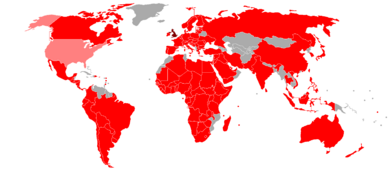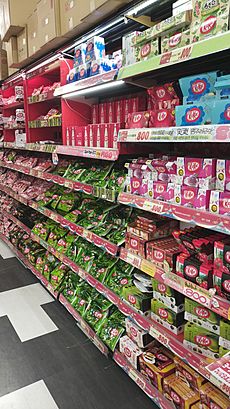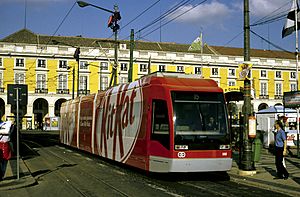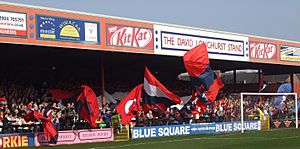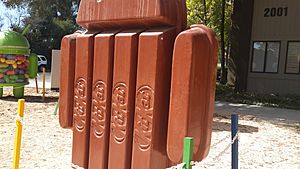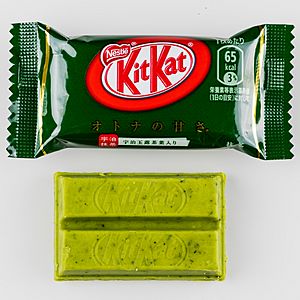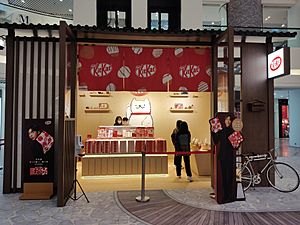Kit Kat facts for kids
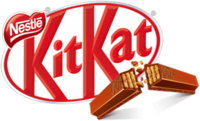 |
|
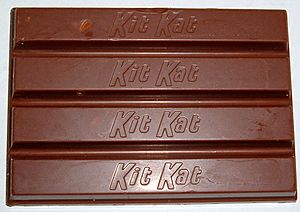
Standard four-finger Kit Kat
|
|
| Owner | Nestlé Hershey's (US licence) |
|---|---|
| Introduced | September 1935 |
| Related brands | Rolo |
| Markets | Worldwide |
| Previous owners | Rowntree (1935–1988) |
| Tagline | "Have a break...Have a Kit Kat!" (Worldwide) "Gimme a break, Gimme a break, Break me off a piece of that Kit Kat Bar!", "Break time, anytime" (US only) |
Kit Kat (sometimes written as KitKat) is a super popular chocolate bar! It's made of crispy wafer covered in yummy chocolate. It was first created in York, England, by a company called Rowntree's. Today, most Kit Kats around the world are made by Nestlé. But in the United States, they're made by Hershey's!
Most Kit Kat bars have two or four "fingers." These fingers are layers of wafer covered in chocolate. You can easily snap each finger off the bar. Kit Kat comes in many different flavors, like milk chocolate, white chocolate, and dark chocolate.
The idea for the original four-finger bar came from a worker at the Rowntree's factory in York. They suggested making "a chocolate bar that a man could take to work in his pack up." It first came out in September 1935 in the UK as Rowntree's Chocolate Crisp. It was later renamed Kit Kat Chocolate Crisp in 1937, and then just Kit Kat after World War II.
Since 1958, the famous slogan for Kit Kat in the UK and many other places has been "Have a break... have a Kit Kat." In the US, since 1986, the jingle in TV ads has been "Gimme a break, Gimme a break, Break me off a piece of that Kit Kat Bar!"
Contents
The Story of Kit Kat
Early Beginnings
The name "Kit Kat" has a long history! It goes back to the 1700s. Back then, a type of mutton pie called a Kit Kat was served at meetings of the Kit-Cat Club in London. This club was owned by a chef named Christopher Cat.
The company Rowntree's in York, England, first trademarked the names Kit Cat and Kit Kat in 1911. They didn't use the names right away. Kit Kat first appeared in the 1920s as a brand of chocolates in a box. Later, Rowntree's focused on other chocolates, and the Kit Cat brand stopped for a while.
The idea for the famous four-finger bar came from a factory worker. They suggested a snack that someone could easily take to work. This bar was launched in September 1935 as Rowntree's Chocolate Crisp.
Changes During Wartime
Rowntree's Chocolate Crisp was renamed Kit Kat Chocolate Crisp in 1937. During World War II, there were food shortages. Because of this, the recipe changed to dark chocolate, and the packaging became blue. After the war, the name became simply Kit Kat, and it went back to the original milk chocolate recipe and red packaging.
Growing Around the World
After becoming popular in the UK, Kit Kat started being sold in Canada, South Africa, Australia, and New Zealand in the 1940s. In 1957, the famous advertising line "Have a Break, Have a Kit Kat" was created.
Kit Kat grew even more in the 1970s. Rowntree's built a new factory in Germany to make more Kit Kats for Europe. They also made deals with Hershey's to sell Kit Kats in the US and with Fujiya in Japan.
In June 1988, a Swiss company called Nestlé bought Rowntree's. This meant Nestlé took over Kit Kat everywhere except in the US. Production and distribution increased, with new factories opening in Japan, Malaysia, India, and China.
Hershey's still makes Kit Kat bars in the United States. This is because of an agreement they made with Rowntree's back in 1970.

New Flavors and Forms
The first new flavor, Kit Kat Orange, came out in the UK in 1996. After that, many other flavors like mint and caramel appeared. In 1999, the bigger Kit Kat Chunky was launched and became very popular. Many new flavors and types of Kit Kat have been created since then.
In September 2010, Kit Kat celebrated its 75th birthday! Nestlé said that Kit Kat has become a big part of British culture and is sold in more countries than any other chocolate brand.
The classic Kit Kat bar has four fingers. A two-finger bar was also launched in the 1930s and is still very popular. The Kit Kat Chunky has one large finger. Kit Kat bars come with different numbers of fingers depending on the country. For example, Japan has tiny Kit Kat Petit bars, while Australia and France have twelve-finger family-size bars.
Kit Kat Around the World
Kit Kat bars are made by Nestlé in 16 countries, including Brazil, Mexico, the United Kingdom, Canada, Australia, Japan, and China. As mentioned, Kit Kat bars in the United States are made by The Hershey Company.
Around 2003, the chocolate industry faced challenges. People were interested in healthier eating. To keep sales strong, companies like Nestlé started making many new and special flavors of their chocolates. These "limited editions" were only available for a short time. This idea helped Kit Kat and other chocolates stay popular.
In 2010, Nestlé opened a new factory line in York, England, to make over one billion Kit Kat bars each year!
Because dark chocolate became more popular for its health benefits, a four-finger Kit Kat Fine Dark was launched in the UK in 2006.
Nestlé now makes two-finger Kit Kats with natural flavors. In February 2021, they announced the first vegan Kit Kat, called "KitKat V." In 2014, Kit Kat was the third best-selling chocolate bar in the UK.
How Kit Kat Looks
When Kit Kat first came out in 1935, it had a red wrapper. It was blue for a short time between 1945 and 1947. The Kit Kat logo was added in 1937.
Since it came to the US in the 1970s, Hershey's Kit Kat packaging and ads have looked different from other countries. In 2002, Hershey's Kit Kats started using a similar slanted logo to Nestlé's, but with red and white colors. The US version of "Kit Kat Chunky" is called "Big Kat."
In the UK, Kit Kats used to be wrapped in silver foil and a paper band. In 2001, this changed to plastic wrapping.
Kit Kat Ads and Fun Facts
Famous Ads
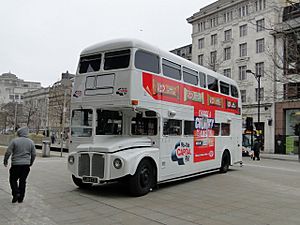
When it first launched, Kit Kat was advertised as "the biggest little meal" and "the perfect companion to a cup of tea." During World War II, ads showed Kit Kat as a good wartime food. The first TV ad for Kit Kat in the UK was in 1958.
The slogan "Have a break... have a Kit Kat" has been used since 1957. In the US, the "Gimme a Break" jingle has been used since 1986. This jingle is so catchy that it's often called an "earworm" – a tune that gets stuck in your head!
Many Kit Kat ads have been popular around the world. One famous UK ad from 1989 showed a photographer taking a break from waiting for pandas. He missed them doing a dance routine! This ad was voted one of the "100 Greatest TV Ads."
From 2004 to 2006, Nestlé Rowntree sponsored the English football club York City F.C.. Because of this, their home stadium, Bootham Crescent, was even renamed KitKat Crescent!
In 2012, Kit Kat had a fun campaign in the UK. People could vote for their favorite new Chunky Kit Kat flavor. Peanut butter won with 47% of the votes!
Kit Kat and Android
In September 2013, Google announced that version 4.4 of its Android mobile operating system would be named "KitKat." Google got permission from Nestlé to use the name, and no money was exchanged. There was even a special promotion where people could win Nexus 7 devices and Google Play Store credit by finding specially branded Android Kit Kat bars!
Fairtrade Chocolate
In 2009, Kit Kat announced that its four-finger bar in Britain and Ireland would start using Fairtrade chocolate. This means the cocoa farmers get a fair price for their crops. This was expanded to the two-finger bar in 2010.
However, in June 2020, Nestlé decided to change. Kit Kat now gets its cocoa from farms with a Rainforest Alliance accreditation instead of Fairtrade.
Golden Ticket Fun
In 2006, there was a fun promotion with the TV show Big Brother Series 7 in the UK. Nestlé hid 100 "golden tickets" inside Kit Kats, just like in the Charlie and the Chocolate Factory story! People who found a ticket had a chance to become a Big Brother housemate.
Different Kinds of Kit Kat
Many Flavors
There have been many different kinds of Kit Kat flavors, some permanent and some for a limited time. In Japan, Nestlé has created over 300 different flavors since 2000! These include interesting ones like hot sauce, soy sauce, wasabi, Ice cream, and even flavors that need to be baked in an oven. These unique flavors are popular with younger buyers and are often bought as good-luck gifts. This is because the name "Kit Kat" sounds like the Japanese phrase "Kitto Katsu," which means "surely win."
The first flavor variation in the UK was Kit Kat Orange in 1996. After that came Kit Kat Dark and Kit Kat Mint. Other flavors have included Kit Kat White and Kit Kat Cookies & Cream.
In 2020, Kit Kat introduced Lemon Crisp and Raspberry Creme flavors in the United States. Also in 2020, Nestlé launched Scotch whisky KitKats, available only in Japan. These chocolates were aged for six months in whisky barrels! In February 2021, the company announced a vegan, dairy-free version called KitKat V.
Different Shapes
Kit Kat bars come in many sizes. There are miniature two-finger bars, the standard four-finger bars, and sometimes three-finger bars.
Originally, each finger had the name 'Rowntree' on it, but this was changed to 'Kit Kat'.
Larger single-fingered "Chunky Kit Kats" were launched in the UK in 1998. They have been sold in flavors like White Chocolate, Caramel, and Peanut Butter.
Other fun Kit Kat shapes include small, round "Pop Choc" pieces, square "Kubes," and even Kit Kat ice cream cones.
In 2014, Japan launched the Bake 'N Tasty Mini Kit Kats Custard Pudding Flavour. You actually have to bake this bar in an oven before you eat it!
In 2015, a fancy new Kit Kat called Kit Kat Rubies was launched in Malaysia. These came in a box of 20 small bars and were made with premium chocolate truffle cream and roasted hazelnuts.
As of 2017, US Kit Kat types include the standard four-finger bars, white or dark chocolate covered bars, and a redesigned Big Kat.
In 2023, a Kit Kat breakfast cereal was even launched in the United Kingdom!
Kit Kat Chocolatory
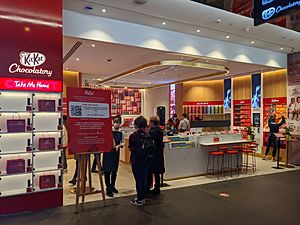
Kit Kat has special stores called "Chocolatories." One is in the Melbourne Central Shopping Centre in Melbourne, Australia. There used to be one in Sydney, but it closed in June 2024.
At these shops, you can use touch screens to create your very own Kit Kat! You choose your favorite chocolates and ingredients, and they make it for you right there. You can even mix your own flavors.
There are also Chocolatory locations in Brazil, Japan, and Canada.
What's Inside Kit Kat?
It was once revealed on a TV show that the filling inside Kit Kat fingers is actually (or at least contains) crushed up Kit Kat!
The main ingredients in a classic Kit Kat include milk chocolate (made from sugar, milk, cocoa butter, and cocoa mass), wheat flour, sugar, and palm oil. Other ingredients help give it its taste and texture, like yeast and sodium bicarbonate.
Ingredients in Europe
In Europe, Kit Kats contain milk chocolate (about 66%), wheat flour, sugar, vegetable fat, cocoa mass, yeast, and a raising agent.
Ingredients in the United States
Hershey's Kit Kat Crisp Wafers in Chocolate contain sugar, wheat flour, cocoa butter, nonfat milk, chocolate, and refined palm kernel oil.
Ingredients in Canada
Canadian Kit Kats have milk chocolate (made from sugar, milk, cocoa butter, and cocoa mass), wheat flour, sugar, modified palm oil, and cocoa. Dark chocolate Kit Kats in Canada use cocoa mass, sugar, wheat flour, and different oils.
In Japan, Kit Kats are made in Nestlé factories. The milk chocolate comes from whole-milk powder, and Nestlé gets most of its cocoa beans from West Africa.
Nestlé also has factories in China that supply Kit Kats to China and Hong Kong.
See also
 In Spanish: Kit Kat para niños
In Spanish: Kit Kat para niños




